Atari Synthcart Demo (photobucket homemade video) offered in connection with Ebay Synthcart auction. Seller not affiliated with Synthcart maker Paul Slocum, as far as we know--this is downstream commerce-slash-music-crit.
Search Results for: atari
from the vault: Video Games and Contemporary Sculpture
Am (still) gradually moving content from my old Digital Media Tree website over to tommoody.us, including an index of published writing examples. I wrote the essay below in 2002 as a self-hosted web-publication. Not sure how well the funky image alignment HTML will work with modern devices but I'll keep it for now.
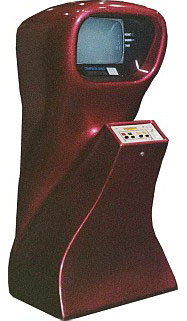
Product design doesn't emerge in a vacuum; it's part of a larger visual history, reflecting developments in technology, fabrication technique, and philosophy that also apply to the purer arts. Before the late '60s, when the scientific pretensions of the high modernist era began to break down, art and design seemed to move in easy parallel, influencing or being influenced by one other. Yet since that time, with the exception of the occasional visionary (or quasi-visionary oddball such as Matthew Barney), art has preferred to take itself out of the equation, offering ironic footnotes and meta-commentary rather than design per se.
For an example of a commercial object planted firmly in the modernist feedback loop, let's consider Nutting Associates' Computer Space game (1971). The first arcade-style game is clearly rooted in the space age design of the late '60s and early '70s. Its body is made of Fiberglas, one of the "new materials" that promised to revolutionize how we live, work, and shop: tough but malleable, able to be molded into pleasing, biomorphic contours, as in the Eames chair and the Corvette Stingray body. Combining the abstract curves of a Henry Moore sculpture with Apollo-era push-buttons and screen technology, Computer Space is delightfully anthropomorphic, with a bulbous head and pseudopod arm proffering its control panel like a robot butler. Typical of science fiction's use of present-day kitsch objects as futuristic props (e.g, the design-store salt shakers as medical instruments in the McCoy-era Star Trek), Computer Space appeared briefly onscreen in the 1973 Charlton Heston vehicle Soylent Green--as a game, however, rather than a piece of newfangled equipment.
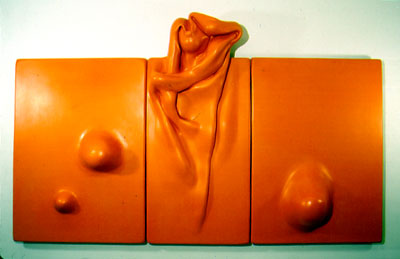
Many artists of the '60s, such as George Rickey and Kenneth Snelson, made objects with the same buoyant optimism and faith in science one sees in the contours of Computer Space. Some of Canadian sculptor Walter Redinger's Fiberglas sculptures fit right in with the NASA aesthetic, while others begin to break away from the upbeat positivism of the '60s and explore its dark side. An untitled wall-piece from 1969, featuring a bizarre, quasi-fetal shape spewing out of the placid surface of a large monochrome triptych, belongs to the latter group. In Redinger's late-'60s-style rhetoric, this phallic-vaginal wraith reflects "the tension which exists between organic and geometric forms," but in retrospect it reads more as a tumorous growth on the picture plane--as if the bodily repression of the Formalist tradition were taking pathological form.
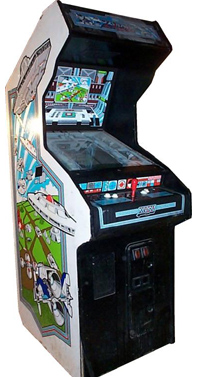
By the '80s, artists had left the design world to fend for itself as they went off to explore the outer reaches of French theory, identity politics, and institutional critique. During this period, video games became functional, box-like, and festooned with tacky graphics: the Xevious game, 1983, for example, featured epic battles of Star Wars-style space ships painted on its sides. The shapes of the consoles may have been utilitarian and ordinary, but the games were popular, thus providing a visual meme that could later be recycled within the art world's self-referential feedback-eddy.
Thus, in Rita McBride’s Machines, 2000, the shapes of "various standard video game consoles found in arcades and neglected bars around the world" (to quote the gallery press release) are presented stripped of all signage and hardware. Made of mass-produced vitreous enamel typically used for industrial signage and subways, the sculptures combine the comforting hues and textures of '50s refrigerators with shapes invoking the design-challenged, shopping-mall '80s. Unlike Redinger's work, however, which was to some extent participating in the grand experiment of its age, McBride's exists at a critical remove from the design world's cycles of innovation and cliche. It comments on the underlying social assumptions of objects without putting too much at risk. That's fine for now, but eventually we may get hungry to see a lava lamp again, as opposed to a "lava lamp."
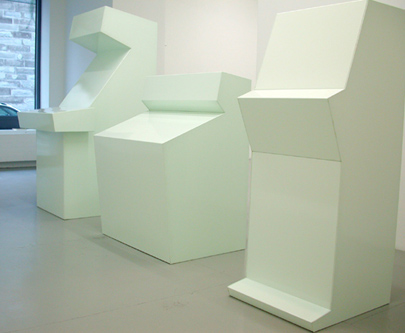
Photos, top to bottom:
Computer Space arcade game (Nutting Associates), 1971
Walter Redinger, Untitled, 1969, Fiberglas
Xevious arcade game (Atari), 1982
Rita McBride, Machines, 2000
PALO ALTO DREAMIN': Towards a New Digital Expression(ism)
by Tom Moody
(originally published in Art Papers, November/December 2001, pp. 20-24)
In the first year of the new Millennium, a wave of U. S. museum exhibits showcased the computer in art. "010101: Art in Technological Times" at the San Francisco Museum of Modern Art, "BitStreams/Data Dynamics" at the Whitney Museum of American Art, and "Digital: Printmaking Now" at the Brooklyn Museum of Art featured painting, sculpture, photography, prints, and video made with (or influenced by) the ubiquitous appliance, along with Internet-related projects. The rhetoric accompanying the exhibits recalled the hopeful, futuristic phrases of the dot-com era. Artists working with digital media "challenge our everyday perceptions of color, form, sound, space, and time," declared the Whitney. "Neither art, nor those who make it, show it, and look at it can ever be the same again," predicted SFMOMA. "Go digital," advised the Brooklyn Museum.
"BitStreams" (including its Internet component "Data Dynamics") was the most cogent of the shows, focusing on artists using the computer as a primary medium, rather than just a newfangled printing device, or a metaphor. (FN1) During its three-month run, the curators filled the galleries with flashing lights, eerie droning sounds, and interactive gadgets; visitors may have thought they'd wandered into the Exploratorium, or an arcade. Yet for all the fun of these toys, the exhibit failed to stir much excitement. Too many images lacked punch or presence. Too many animations recalled software demos. Too many projects seemed incomplete, as if the artists had followed the letter but not the spirit of Jasper Johns's advice to "take something, do something to it, and do something else to it." (Subtract information from photo in Photoshop. Print photo. Frame.)
The sad thing is, there's still a good exhibit out there waiting to be done. These are exciting times, not because artists are showing us the future but because they're finally making work that doesn't scream "computer art" (or at the very least, because they're successfully hybridizing digital ideas with other forms). Unfortunately the "BitStreams" curators fell into the trap of making it a "tech show," full of spanking new consumer products and entertainment for the kiddies, seemingly unconcerned that, in the art community, at least, such exhibits have had limited impact (remember kinetic art? holography?). Instead of flouting viewer expectations, looking for disobedient, ecstatic, Dionysian uses of the computer--stuff close to the spirit of art, in other words--they emphasized the analytical data-crunching that everyone already knows it does well.
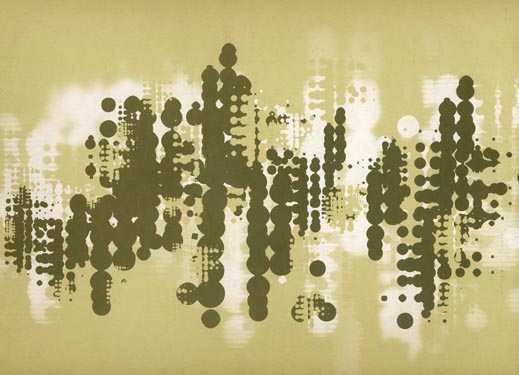
Tom Hingston, Kid Loops Sleepwalk EP cover (detail)
The most interesting story about the computer is how it's misused as an art-making tool: how a device originally designed to make smoother curves, cleaner sounds, and crisper copies turned out to be even better at chopping reality into bits, rearranging it beyond recognition, and "dirtying it up." This methodology thrives outside the art world, in the dynamic title sequences of films like David Fincher’s Se7en, in the scintillating "vocal science" of New Jersey garage producer Todd Edwards, and in the disorienting Adobemania of drum-and-bass flyers. It also lives in the collages of Albert Oehlen, in web projects like jodi.org, and in the expressionistic drawing and painting of Marsha Cottrell, Claire Corey, and Matt Chansky (more on them below). (FN2) Yet despite the inclusion of a few token lo-fi pieces, the Whitney gave this narrative short shrift, in favor of the one we know and expect to hear: the story of the computer as a purveyor of artificial realities, a kind of "augmented brain" for humanity.
Let's consider a few examples from "BitStreams." In John Klima's large interactive video projection ecosystm, 2000, flocks of imaginary birds swoop and bank through virtual, primordial cloudscapes, accompanied by ominous musical chords. Animated roughly at the level of a Sega game, the fanciful, streamlined "birds" recall pterodactyls and helicopter seeds, but are essentially just bodies with wings. Responding to data from a live Internet feed, the flocks grow or shrink in size as worldwide currencies fluctuate, and "attack" each other when markets become agitated. Using a set of Playstation controls, the viewer can fly among the flocks, in observation mode only, and switch on or off the data, which appears as charts and graphs superimposed on the screen.
What most viewers don't know is that Klima has worked as a programmer for Dun & Bradstreet and Turner Broadcasting, and that he created the piece as a commission for a financial-products company CEO. The connection between money and interspecies warfare was suggested by the executive's view of markets as "natural phenomena." (Since when did artists start getting ideas from bankers?) (FN3) Yet this grand Darwinian vision is probably lost on most people goofing around with the control buttons. In William Gibson's vision of cyberspace in Neuromancer, 1984, the console cowboy actually knows how to read the abstract symbols representing encrypted data. Here, the viewer just zooms around in a big video game environment, having a clueless blast.
In The Top Grossing Film of All Time, 1 x 1, 2001, Jason Salavon does something technicians are often guilty of: using the computer to perform a task just because it can. This chromagenic c-print was described in the exhibition guide as a digital "portrait" of the film Titanic: "Each...of the film's 336,247 frames has been digitally averaged according to its predominant color," it said, with "the frames...arranged in chronological sequence to produce an all-over abstraction that allows [the film] to be literally encompassed in the blink of an eye." Yet that abstraction tells us next to nothing about the film's content, and isn't compelling enough to be an ironic comment on gratuitous high-tech. Scanning the rows of tiny, horizontally arranged squares, suggesting a contact sheet or microscopic thumbnails, about all the viewer can do is ask inane questions like "Is that flesh colored band where Kate and Leo were having sex?"
Another artist doing the obvious with the computer is Jeremy Blake (also included in "010101"), whose animated, multiscreen presentations depict modernist grids morphing slowly in and out of stylized architectural spaces: a bachelor pad apartment, a Mediterranean villa, Japanese train-station lockers. Combining video game immediacy with art world elegance, his work has a hint of a design critique (depicting urban space as delerious, scene-changing spectacle) and a sleekness and richness of color that has caught the eye of collectors. While his animations are simple next to Hollywood's most run-of-the-mill magic--for example, the letters turning and pivoting in deep perspective space at the beginning of Paul Verhoeven's film Hollow Man--the software and plasma screen displays he uses are new to the art world, and that, combined with a certain polish, has buyers reaching for their checkbooks.
Of course in Hollywood movies there is a learning curve, or law of diminishing returns, with respect to new technology: an initial "wow" followed by rapid audience acclimatization, boredom, then demand for new tricks. Almost everyone knows the leaps of virtuality that occurred between Tron, 1982, and Shrek, 2001, transitions that required progressively more computing power but didn't necessarily yield better movies. To produce a film like Final Fantasy: The Spirits Within today requires nothing less than a "render farm," described by the Los Angeles Times as "a roomful of refrigerator-sized computer stacks." (FN4) All that hardware is a creative dead-end--the entertainment equivalent of Cold War defense spending--but if Blake's success raises the technological bar for other artists, that's where we're headed.
But to reiterate: it doesn't have to be that way. The story of computers in movies is one trajectory; a more interesting counter-trend is what happened in music in the mid-'80s, with sampling technology. One may recall that the first samplers were so expensive only rock stars could buy them: Frank Zappa owned New England Digital Corporation's Synclavier, and Stewart Copeland of the Police worked with its Australian counterpart, the Fairlight CMI. With the introduction of cheaper instruments such as the Ensoniq Mirage and Akai S1000, however, the means to copy, alter, layer, and timestretch (change speed without altering pitch) became available on a mass scale. Musicians working in basement studios suddenly had the freedom to play around with the technology, prompting the emergence of whole new genres based on quoting and mutating available sounds.
With the sampler, hiphop groups like Ultramagnetic MCs, Public Enemy, and a Tribe Called Quest took early '80s dj-style mixing to even more mind-bending levels, digitally splicing in spoken word clips, recontextualized hooks from old pop tunes, secondhand syncopation, and chunks of random noise, often tweaked into unfamiliar frequencies and timbres. By the '90s, sampler-driven hiphop had crossed the Atlantic and been transformed (by way of Belgian techno and other precursors) into "jungle," a jittery, drug-fueled sound that combined the dub and ragga influences of multiracial, inner-city London with floor shattering basslines and increasingly sped-up breakbeats. All of this is original, digital sound art, emerging unpredictably from street-level and rising to the highest peaks of complexity and nuance. (In "BitStreams," all the sound art was ambient, sending the somewhat snooty message that "rhythmic equals low.")
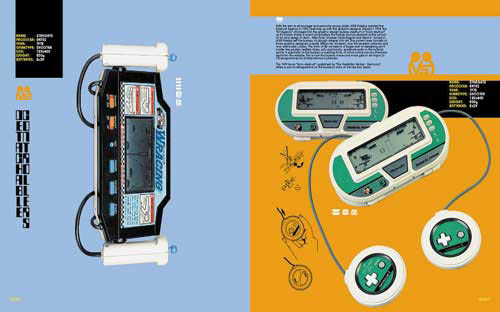
Lopetz (from Büro Destruct), thumbnail book pages from Electronic Plastic (Berlin: Die Gestalten Verlag, 2001)
In the visual realm, hiphop and jungle found their counterparts in rave- and club-related graphics: CD covers, 12-inch record sleeves, and concert flyers produced by legions of anonymous (or pseudonymous) mouse-clickers, as well as higher-profile collectives like Designers Republic and Switzerland's Büro Destruct. These artists pioneered a look and feel to complement the music, merging Berlin Dada agitprop, Japanese "pop" lettering, and Atari-style bitscapes in a perplexing barrage of bold color and gorgeous metallic ink. Instead of the sampler, it was the scanner and the screen shot that opened up the entire visible universe to quotation and recombination. Just as '80s synth-groups exhaustively listed instruments on record sleeves, the graphics firms proudly catalogued the hardware and software used to make their de-centered, hard-edged, "wild-style" designs: "Amiga 500, Amiga 1200, Apple IIc, Power Mac G3/300, Adobe Illustrator, Iomega ZIP-drives, UMAX S-12 Scanner, AGFA ePhoto 1280, Nintendo GameBoys..." (FN5)
Art and graphics are two different things, but sometimes the fields overlap, as with Russian Constructivism, Pop art in the '60s, and graffiti-related art in the '80s. Right now abundant, inexpensive imaging technology and quantum advances in consumer printing equipment (e.g., the EPSON line) have inspired a frenzy of experimentation, with artists and designers alike exploring the expressive opportunities (and limitations) of this emerging medium. Artists involved with the club scene may actually have an edge at the moment, because they've been at it longer and have a support system. While the art world has been dithering about whether or not work will "last," technologically and archivally, and hedging its bets by showing paintings "based on" (but not made with) the computer, the underground has shown no such hesitancy--records must have covers!
Which brings us to Matt Chansky, Claire Corey, and Marsha Cottrell, three artists doing some of the most interesting pieces in two dimensions with the computer right now. Working instinctively (and for the most part, abstractly), they are tweaking settings, experimenting with printing and paper, figuring out what are "cheesy," engineer-inspired effects and what aren't. Like the underground's, their imagery is both dynamic and oblique, with "deconstruction" expressed as a habit of mind rather than a literal social comment: a tacit refusal to use the computer on its own, industry-defined terms. Information from the immediate, scannable universe is imported, dismantled, and reassembled; motifs are shuttled back and forth among programs; machine error is exploited for artistic effect.
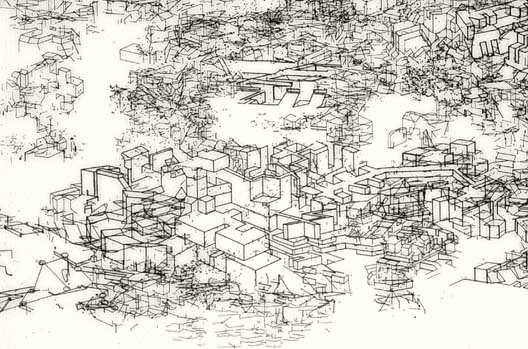
Marsha Cottrell, Untitled #20 (detail), 1999, unique laser print on Mylar, 8.5" x 11"
In Cottrell's work, punctuation marks--slashes, commas, colons, brackets--are fragmented and stretched into hair-thin lines, which serve as the raw material for chaotic or crystalline abstractions. Printed in black and white on Mylar sheets resembling vellum, these semi-amorphous blurs suggest architectural plans for oddly-angled, retro-futuristic cityscapes, growing and decaying in fractal swamps. By repurposing characters from a standard font file, originally meant for word processing, into a malleable, intricate drawing medium, she practices a kind of cyber-alchemy: as critic Sarah Schmerler eloquently puts it, "Cottrell isn't simply making drawings with a new medium, she's using it as a kind of poetic device, creating pictorially compelling spaces out of the pauses within speech." (FN6)
Matt Chansky also imports typography (as well as clip art, error messages, and other information) into his digital paintings, and after he has applied "wash" or "rinse" files that soften or intensify the images, it becomes difficult to tell these sources apart. Often it's not clear if what the viewer is seeing are gestures in a paint program, fuzzed-out, clip-art drips, or actual paint (it's printed ink, but laminated behind Plexiglas it's hard to tell). Sometimes Chansky samples the computer's "display errors," which are fields of pixelated static occurring when the machine is taxed for memory. He has learned how to create these one-off patterns--seductive, mazelike networks of horizontals and verticals--by deliberately putting the computer under stress, introducing specific images as a sort of catalyst and taking screen captures of the results. (FN7)
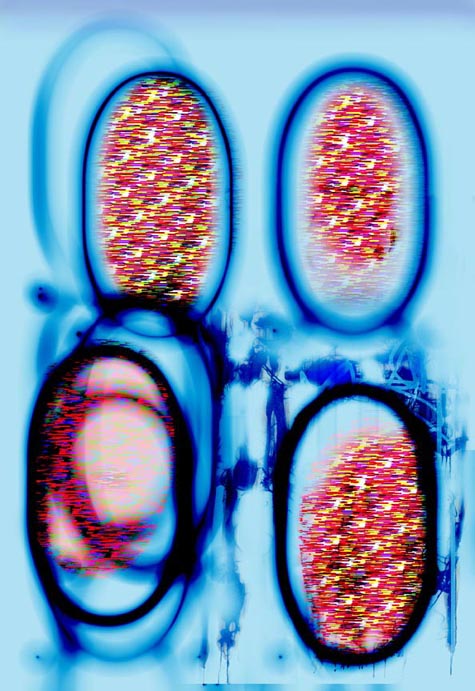
Matt Chansky, Static & Blues_4, 2001, ink on paper, Plexiglas, 50" X 34"
After further "cultivation" and "maturation" in an imaging program, he integrates the captures into larger compositions. In Static & Blues_4, he places four oval-shaped patches, all based on the same error (with varying constituent colors added or subtracted so no two patches look alike), slightly off-register within loops of what looks like drippy, washy paint. The resulting image is an iconic, punning take on the spiritualist impulse, as it has evolved between the early 20th Century and now. While the painted areas suggest messages coming "from within" the artist by mediumistic transcription (or via its descendant, AbEx gesture painting), the pixelated areas are snapshots of the machine's unconscious. Only the latter, however, are truly "automatic."
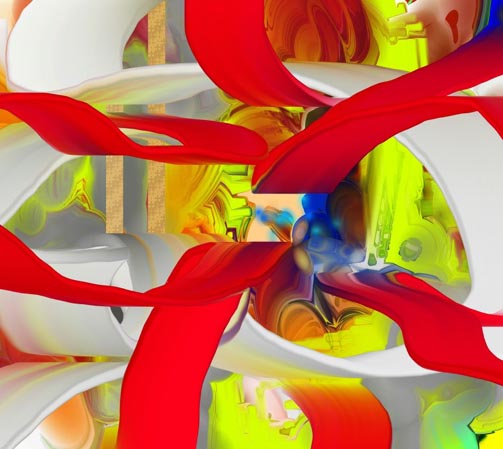
Claire Corey, 6c1a3b, 1999, ink on paper, 50" X 56"
Claire Corey's digital paintings also play with our neurotic need to know what we're staring at. Printed on heavy paper stock with Iris technology, they look like watercolors, or perhaps thinned-down acrylics, except that they completely disregard the physical limitations of those media. Arcs and loops that appear hand painted are subtly intertwined with hard-edged geometry, then further distorted, layered, and refracted using effects that could only come from computer menus: imagine Abstract Expressionist-style painting with the added ability to filter, wave, clone, and "spherize." Corey avoids the cliches of imaging software (and AbEx) through obsessive, over-the-top reworking of imagery--her paintings are staggeringly complex, nesting details within details like the recursive worlds in Mandelbrot sets. She uses several different programs, moving motifs back and forth among them, discovering new effects through the computer's almost infinite ability to recombine imagery.
Like Chansky's "static" piece, her 1d4o, printed on canvas, contrasts the grid with organic surroundings, so violently they appear to be at war. A woven pattern from a digital clip art file is altered, color by color, into a new arrangement of hues, then tilted at a perspectivally steep angle and immersed in a field of vaporous, high-key color. Diaphanous veils of chartreuse and magenta--more like negative overlays in photography than painting glazes--surge up from the bottom of the piece and crash against the grid like waves assaulting a battleship. Miniature black holes emerge from the vitriolic swirls to envelop and "eat" the grid, while fragmented clones of the plaid hover around the periphery like fourth dimensional flotsam and jetsam. Despite the sci-fi metaphors, the piece isn't a modernist "challenge to our everyday perceptions" so much as it is an honest reflection of them: a torqued-up hybrid of cinematic tropes, cyber-effects, and upscale painting conventions.
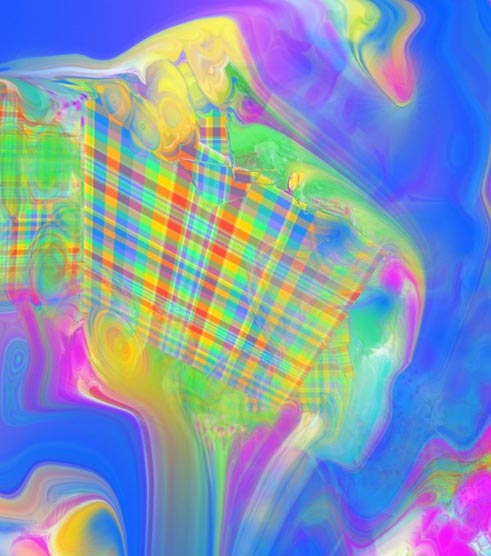
Claire Corey, 1d4o, 2001, pigment on canvas, 56" X 50"
In his "BitStreams" review, New York Times critic Michael Kimmelman questioned the long-term viability of digital work, fretting that "today's hardware and operating systems, the digital equipment artists use, will be replaced shortly by a new generation of equipment." In the work of Cottrell, Chansky, and Corey, that's not really an issue. Kimmelman fails to mention that imaging software hasn't changed fundamentally since the early '80s, when Apple added MacPaint to the desktop interface developed by Xerox PARC (Palo Alto Research Center). Nowadays, programs are pixel-based (Adobe Photoshop) or vector-based (Adobe Illustrator), they involve either layering (Photoshop again) or mapping textures onto polygonal armatures (a la Pixar and Industrial Light & Magic), but you still have the same combination of drawing board, tool menus, and spectrum bar you did twenty years ago. Programmers and engineers have refined these basics, added more depth and memory, improved printing and screen technology, but haven't radically rethought how images are made. Until that happens, resolution remains largely a matter of taste, which the best artists know how to use proactively.
Critics have also accused artists of just following steps in these programs, creating high-tech paint-by-numbers. Whether true or not, that certainly comes to mind looking at Jeremy Blake's photos and DVDs, which are as robotic as architecture-program renderings. But the expressionistic mode favored by Cottrell, et al--heavy on revision and erasure, moving back and forth between programs, importing "foreign" material, actively exploiting breakdown and error--is about as far removed from factory settings as you can get. That mode may be the most interesting place for visual artists to work in computers right now, because it is counterintuitive (as opposed to the Ellsworth Kelly-style grid, which conforms easily to the computer's right-angled design scheme); because it's closer to the impure, inclusive spirit of hiphop; and because its open-endedness thwarts soundbite explanations.
The biggest challenge for artists isn't keeping up with technology, it's navigating what's already there. (FN8) The range of artistic choices in existing programs, good and bad, is mind-boggling: millions of colors, line weights, effects, filters, orientations, and layers, as well as combinations, and combinations of combinations, of the above--and that's before the first scan is even imported. Just as hiphop producers and graphic artists don't need expensive upgrades (or grant-friendly rationales) to do their work, neither do Chansky, Cottrell, and Corey; they're deconstructing at ground level, so to speak. Perhaps in the next round of "computer shows," their influence--and the expressionistic turn in digital painting--will be more strongly felt.
FOOTNOTES
FN1 "010101" included non-computer-based work--e.g., Sarah Sze's dismantled Jeep Cherokee, and an ambient installation by the computer-hating Brian Eno--under the vague rubric of "technological times." "Digital" focused on digital printmaking, which is a mere sideline for artists like Jim Dine, Kiki Smith, and Chuck Close, who are better-known for working in other media.
FN2 www.jodi.org is a low-tech meltdown of typography, computer game imagery, and multi-layered cyber-detritus. Jodi (Dirk Paesmans and Joan Heemskerk) have also done downloadable pieces that mangle the web pages by reading their code in the 'wrong' way. Cottrell was included in the Brooklyn Museum show; but none of the other artists mentioned were in "BitStreams" or "010101."
FN3 David Colker, "Net Works," Los Angeles Times, April 19, 2001.
FN4 M. Hiltzik and A. Pham, "Synthetic Actors Guild," Los Angeles Times, May 8, 2001, page A-1.
FN5 BURO DESTRUCT (Berlin: Die Gestalten Verlag, 1999), p. 190.
FN6 Sarah Schmerler, review of "Cyber drawings," Art on Paper, May-June 2000, p. 81
FN7 Emails from Matt Chansky, May 29 and July 30, 2001
FN8 Some programmers claim that you have to be able to write code to be original, but as artist John F. Simon (who writes code) has said, "I believe artists who work from a strong personal vision will make interesting art with Photoshop or anything else they find necessary to realize their ideas." He adds: "That said, using a software tool by just following the demos and the menus is going to produce very similar results." "Decoding Digital Art," interview with John F. Simon at mediachannel.org.
recursive alto
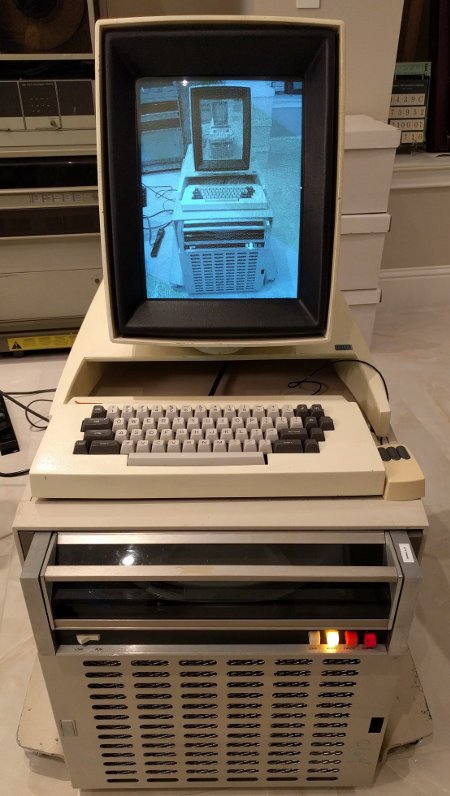
Ken Shirriff has been restoring a vintage Xerox Alto computer (the PC Steve Jobs "borrowed" his ideas from). Using the BCPL programming language, a precursor to C, he made this image of an Alto on an Alto on an Alto [etc]
Before Wikipedia such an image would have been called infinitely recursive and everyone would have known what you meant ("infinite" within the limits of screen resolution, of course). Now the Wikipedians are encouraging us to use the term Droste Effect, after an obscure cocoa package design. Thanks, I'll pass, but Redditnerds are all over it with an online festival of recursive computer screen images they're calling Droste Week. Here's a typical example (most of these aren't very infinite):
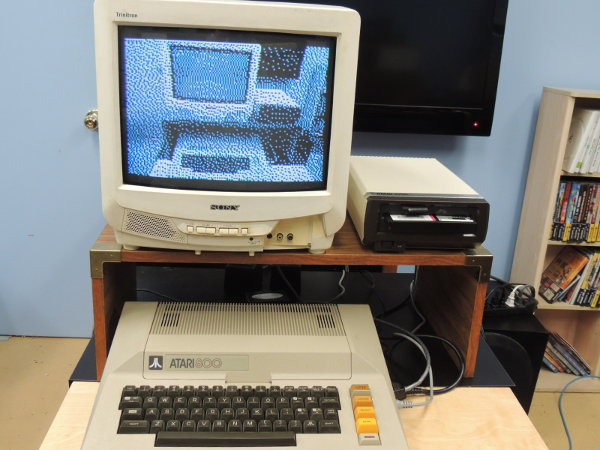
Notes on Tristan Perich's "Parallels" (with Meehan/Perkins Duo)
This live, outdoor MOMA Nights event took place Thurs, Aug. 15, with excellent, unseasonably cool evening weather for a packed Sculpture Garden audience. Perich was offstage, letting his electronics do their thing, while Meehan and Perkins played triangles and hi-hat cymbals processed through his pedals/software/speaker rig. The piece recalled a late-'60s Steve Reich or Terry Riley jam and went on continuously for about an hour without letup. The main timbre was a Farfisa organ-like tone that spit out variegated trills and arpeggios within a somewhat limited tonal range. Midway through the hi-hats added human-played percussive textures. The mid-range "organ" was occasionally relieved by bass notes but it mostly hammered at one spot in your ear.
The piece was not an endurance work compared to Terry Riley's all-night organ-and-delay-pedal concerts but it certainly taxed this supra-bohemian audience sipping from champagne flutes and munching seasonal snacks and bruschetta selections. A few people voted with their feet.
As a believer in one and a half minute songs, this listener kept wanting to edit down to a few nice sections, and in about five places thought "this would be a good ending place."
Feats of endurance aren't all that impressive but you have to give points for the inventive musical ideas and surprises that kept popping up throughout the hour. The software and/or players generated some really exquisite clusters and runs of notes in purely Western, well-tempered scales.
It was possible to close your eyes and imagine three or four layers of sound: the street noise of midtown (a dull roar), the "organ," high pitched squeaks and chimes (a sort of residue of the metal triangles), and percussive white noise slaps.
As for the methodology, it was hard to tell what the software was doing exactly. Per the MOMA website "the piece is Perich’s first to combine order and randomness in the programming of 1-bit waveforms," but usually "one bit" conjures raspy square and/or pulsewidth waves, a la Atari games. None of that was heard. To this untutored ear it sounded like software was sampling a part of the triangle sound and removing decay and transients to generate those "pure" sounding organ tones, and then adding arpeggiation and a certain amount of randomness, in real time, as the players were playing.
